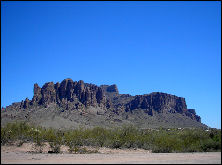Main Listing Page
Gold Spanish Treasure In The Superstitions
East of Phoenix, Arizona is the Superstition Mountain range, more commonly referred to by locals, as the "Superstitions.” Standing majestically at the forefront of this rough terrain is Superstition Mountain, a 3,000 foot high monolith, which seeming stands guard over the rest of its territory.
For more than 120 years, the legend of the Lost Dutchman Mine has been told over and over , growing in proportions to such an extent that some claim the entire legend is nothing but a myth. But for thousands of others, the mine and its legends are extremely real, hidden in the forbidding peaks of the Superstition Mountains.
Real” or not, the haunting tales endure, continuing to draw prospectors to the Superstition Mountains today, and making the story one of the most famous lost treasure tales of all time in the American West history.
When the Spanish arrived in 1540, the region was inhabited by the Apache Indians, who considered Superstition Mountain to be sacred ground, as it was home to their Thunder God. Led by Francisco Vasquez de Coronado, the conquistadors cared little about the Apache customs or beliefs, wanting only to find the legendary "Seven Golden Cities of Cibola.”
Learning from the Apache, that the range did in fact hold gold, the Spaniards were intent upon exploring the area. The Apache; however, refused to help them, telling them that if they dared to trespass on the sacred ground, the Thunder God would take revenge upon them, causing tremendous suffering and horrible deaths. The Indians called Superstition Mountain the "Devil’s Playground.”
But the Spaniards were determined and began to explore. Almost immediately, men began to mysteriously vanish, to the point that warnings were given to never stray more than a few feet away from the rest of the group. Still, more men disappeared only to be later found dead, their bodies mutilated and their heads cut off.
In fear, the conquistadors finally fled, refusing to return to the mountain, which they dubbed Monte Superstition. The legends had begun. A century and a half later Jesuit priest Eusebio Francisco Kino, whose objective was to establish missions and Christianize the savages, was lured by the tales. In the first decade of the 1700’s he began to explore the region, finding several sources of gold. Though it is not known if he found the fabled Dutchman’s Mine, his forays did produce the coveted shining metal, adding more fuel to the legend of gold in the Superstitions. However, these expeditions further enraged the Apache, who then began to prey on all trespassers.
In 1748, the Superstitions, as well as some 3,750 square miles of what is now Arizona, were given to Mexican cattle-baron, Don Miguel Peralta of Sonora, in a land grant.
The land not only contained a rich gold mine, but also several silver mines. This was the first official recording of the mine’s existence. For the next century, the Peralta family and their labourers would make infrequent forays into Arizona, bringing out loads of ore. However, aware of the Apaches' displeasure, they kept these mining trips at a minimum, not wanting to risk the ferocious Apaches' ire. However, in 1846, four descendants of the original grant, Enrico, Pedro, Ramon, and Manuel Peralta, decided to make another foray into Arizona, risking not only the "curse,” but also the wrath of the Apache. They soon returned to Sonora, laden with gold and planning another trip.
The next year, with the Mexican War in full swing, Pedro was the only one willing to return to Arizona, determined to extract as much gold as possible before their holdings became part of the United States. In the meantime, the Apache were angry at the intrusion upon their sacred grounds. When the Peralta miners heard that the Apache might attack, they packed up, concealed the entrance to the mine, and with burros and wagons laden with gold, began to make their way back to Mexico in the winter of 1847-1848. But, they wouldn’t make it. They were attacked by the Apache and every single man was killed. The pack mules scattered in all directions, spilling the gold everywhere. For years afterwards, as the sole surviving member of the Mexican party told the tale, prospectors flocked to the area not only in search of the mine, but also in search of Mexican gold spilled during the massacre.
In the 1850’s, two prospectors are said to have come upon three dead burros with intact pack saddles that contained some $37,000 worth of gold. The Peralta family refrained even more from working the mines for the next 16 years. However, in 1864, Enrico Peralta, leading some 400 men, ventured back into the range. It would be his last. On the northwest slope of the mountain, in an area now referred to as "Massacre Ground,” all but one of the miners was ambushed and killed by the Apache. Never again did the Peralta family venture back to the mine and all maps and knowledge of its location were lost through the years.




